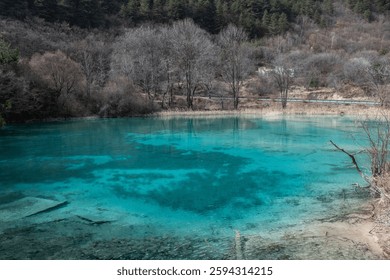Unforgettable Experiences in Jiangnushi: From Historical Sites to Breathtaking Landscapes

An Essential Guide to Visiting Jiangnushi_Site
Nestled along the shimmering shores of Bohai Bay in Liaoning Province, the Jiangnushi Site (姜女石遗址) offers a captivating glimpse into China’s rich cultural tapestry. This historic site, steeped in legend and natural beauty, is known as the resting place of the famous figure Meng Jiangnu, who is said to have leapt into the sea in despair over her husband’s fate during the construction of the Great Wall. The Jiangnushi Site is not just a poignant reminder of love and sacrifice; it is also a striking natural formation—an impressive sea stack that stands as a sentinel over the waves.
As you approach this enchanting landmark, you’ll be greeted by breathtaking coastal views and the gentle sound of the ocean crashing against the rocks. The site serves as a powerful symbol of resilience and loss, drawing visitors from around the globe to reflect on its poignant history. Whether you’re a history buff, a nature lover, or simply in search of a picturesque spot to unwind, the Jiangnushi Site promises an unforgettable experience.
Prepare to immerse yourself in the legends of Meng Jiangnu, explore the surrounding natural beauty, and connect with the rich heritage that this site encapsulates. The Jiangnushi Site is not just a destination; it is a journey through time, where the stories of the past continue to resonate against the backdrop of the ever-changing sea.
In This Guide
- An Essential Guide to Visiting Jiangnushi_Site
- The Rich History and Legends of Jiangnushi_Site
- Main Highlights: What You Absolutely Can’t Miss
- Planning Your Visit: A Practical Guide
- Tickets: Prices, Booking, and Tips
- How to Get There: A Complete Transportation Guide
- Local Cuisine and Accommodation Nearby
- Frequently Asked Questions
- Final Thoughts on Your Trip
The Rich History and Legends of Jiangnushi_Site
Nestled along the shores of the Bohai Sea in Liaoning Province, the Jiangnushi Site (姜女石遗址) holds a captivating tapestry of history and legend that continues to intrigue visitors and historians alike. This site, known primarily for its association with the poignant tale of Meng Jiangnu, is more than just a geographical landmark; it is a cultural symbol steeped in the rich folklore of ancient China.
The Legend of Meng Jiangnu
The story of Meng Jiangnu is one of love, loyalty, and loss, deeply resonating with the people of China. According to legend, Meng Jiangnu’s husband was conscripted to build the Great Wall during the Qin Dynasty. As the seasons passed, the wall was erected, but her husband succumbed to the harsh conditions of labor and died, buried beneath the very stones that were meant to protect the empire. Heartbroken, Meng Jiangnu traveled to the wall to search for him. When she arrived, her sorrow was so profound that she wept bitterly, her tears causing a section of the wall to collapse, revealing her husband’s remains. This act of love and despair not only emphasized the heavy toll of war but also underscored the enduring human spirit.
Historical Significance
The Jiangnushi Site, often referred to as Jiangnu Stone, is believed to be the very location where Meng Jiangnu’s tragic and heroic tale unfolded. The site is located near the ancient military corridors that once served as crucial defense lines along the coast, specifically in the vicinity of Shanhaiguan, a strategic gateway between land and sea.
Archaeological findings in the area suggest that it has been occupied since the Qin and Han dynasties, with remnants of ancient structures and tools that provide insights into the lives of those who resided here centuries ago. The site features a unique natural rock formation resembling a stone pillar, which has earned it the nickname “the stone of Jiangnu.” This striking feature not only captures the imagination but also serves as a physical reminder of the legends that have shaped the cultural landscape of the region.
Cultural Heritage
Today, the Jiangnushi Site is recognized as a historical and cultural heritage site, drawing visitors from far and wide. Tourists are often seen wandering through the remnants of ancient walls, gazing at the imposing rock formations, and reflecting on the legend that has immortalized Meng Jiangnu in the annals of Chinese folklore.
Local festivals and cultural events often celebrate this legendary figure, with performances and storytelling that breathe life into her tale. These events not only honor the past but also connect the present generation with their cultural roots, ensuring that the legacy of Meng Jiangnu endures.
Conclusion
A visit to the Jiangnushi Site is not just a journey through a scenic landscape; it is an exploration of a rich narrative that intertwines love, sacrifice, and resilience. As international travelers traverse its grounds, they are invited to immerse themselves in the poignant history and legends that continue to echo through the ages, making this site a truly unforgettable part of their journey through China. Whether you are an admirer of history, a lover of folklore, or simply in search of breathtaking scenery, the Jiangnushi Site offers a unique glimpse into the heart of Chinese culture and its timeless stories.

Jiangnushi_Site.
Main Highlights: What You Absolutely Can’t Miss
When exploring the intriguing Jiangnushi Site (姜女石遗址) in Liaoning Province, travelers will uncover a treasure trove of history and natural beauty. Here are the must-see highlights that you absolutely cannot miss during your visit.
1. The Enigmatic Jiangnu Stone (姜女石)
At the heart of the Jiangnushi Site lies the famed Jiangnu Stone, or Jiangnu Tomb. This natural sea erosion pillar is not just a stunning geological formation but also steeped in legend. According to folklore, it marks the spot where Meng Jiangnu, a figure from Chinese mythology, reportedly drowned herself in despair over her husband’s fate. The stone stands as a poignant symbol of love and sacrifice, drawing visitors seeking both beauty and a connection to ancient stories.
2. Panoramic Views from the High Platform
The site features an elevated platform that offers breathtaking views of the surrounding seascape, including the picturesque Bohai Bay. Standing here, one can appreciate the majesty of the coastline and the unique geological features of the area. It’s an ideal spot for photography enthusiasts looking to capture the serene beauty of nature combined with historical significance.
3. Archaeological Significance
Jiangnushi Site is not only a place of natural wonder but also an archaeological landmark. The site encompasses remnants of ancient structures, including the “Stone Tablet Land” where a central compacted earth platform stands. This area is believed to have been significant in ancient rituals and community gatherings. Exploring these remnants provides a fascinating glimpse into the life and customs of past civilizations that once thrived in this region.
4. The Scenic Black Mountain Head (黑山头)
Adjacent to the Jiangnushi Site, visitors can explore the stunning Black Mountain Head. This scenic area is characterized by its dramatic cliffs and lush greenery, offering picturesque hiking trails that lead to breathtaking vistas. The natural beauty here complements the historical atmosphere of the site, making it a perfect spot for leisurely walks and contemplation.
5. Cultural Exhibits and Interpretive Centers
To enrich your understanding of the site’s significance, make sure to visit any available interpretive centers or cultural exhibits. These facilities often feature displays on local legends, archaeological finds, and the historical context of the Jiangnushi Site, allowing you to deepen your appreciation for this remarkable location.
6. The Surrounding Coastal Area
Don’t miss the chance to explore the nearby coastal areas, including the tranquil Zhimiao Bay (止錨湾). Known for its clear waters and sandy beaches, it’s a perfect spot to relax after a day of exploration. Enjoy the fresh sea breeze, indulge in local seafood delicacies, and immerse yourself in the laid-back coastal atmosphere.
7. Engagement with Local Legends
While visiting, engage with local guides or literature that delve into the rich tapestry of stories surrounding the Jiangnu Stone. Understanding the legends, such as that of Meng Jiangnu, adds a deeper layer to your experience, connecting you to the cultural heart of the region.
Conclusion
Jiangnushi Site offers a captivating blend of natural beauty, rich history, and cultural significance. Whether you’re drawn by the legends of Meng Jiangnu, the stunning landscapes, or the archaeological wonders, this site promises an unforgettable experience for international travelers eager to explore the depths of Chinese heritage. Embrace the journey and let the stories of the past guide your exploration!

Jiangnushi_Site.
Planning Your Visit: A Practical Guide
Visiting the Jiangnushi Site (姜女石遗址) offers travelers a unique glimpse into Chinese folklore and history, all while basking in the stunning natural beauty of the Liaoning Province. Here’s a practical guide to help you plan your visit to this remarkable site.
Getting There
Location: The Jiangnushi Site is situated in Suizhong County, close to the Bohai Bay, making it accessible from various nearby cities.
By Air: The nearest major airport is Shenyang Taoxian International Airport (SHE), approximately 200 kilometers away. From the airport, you can take a train or hire a car to reach Suizhong County.
By Train: Suizhong has its own train station with connections to major cities. Trains to Suizhong from Shenyang and Dalian are frequent and comfortable.
By Car: If you prefer to drive, you can rent a car from major cities. The roads are generally in good condition, and the scenic drive offers beautiful views of the coastal landscape.
Best Time to Visit
The ideal time to visit Jiangnushi Site is during the spring (April to June) and autumn (September to October) months when the weather is mild and the scenery is particularly beautiful. Summer can be hot and humid, while winter may bring chilly temperatures.
What to Expect
The Jiangnushi Site is renowned for its legend associated with Meng Jiangnu, a woman who, according to folklore, wept for her husband who died while building the Great Wall. The site features natural coastal erosion columns, known as the Jiangnu Stone, which are said to be reminiscent of the historical marker referenced in ancient texts.
You will find:
- Stunning Coastal Views: The site offers breathtaking views of the Bohai Sea, with fresh air and a tranquil environment.
- Cultural Significance: The site is imbued with cultural heritage, drawing visitors interested in folklore and history.
- Local Flora and Fauna: The surrounding area is rich in diverse plant and animal life, making it a wonderful spot for nature lovers.
Exploring the Site
Once you arrive, take your time to explore:
- Jiangnu Stone: This natural formation is the centerpiece of the site. Its unique shape and historical significance make it an excellent photo opportunity.
- Walking Trails: Several trails lead around the site, providing access to various viewpoints and the chance to enjoy the local landscape.
- Guided Tours: Consider joining a guided tour to gain deeper insights into the history and legends connected to the site.
Nearby Attractions
While visiting Jiangnushi, consider expanding your itinerary to include:
- The Great Wall at Jiayuguan: A short drive away, this section of the Great Wall offers a glimpse into its historical grandeur.
- Bohai Bay: Enjoy the coastal scenery and perhaps indulge in some fresh seafood from local vendors.
- Suizhong’s Historical Sites: Explore additional cultural landmarks in the surrounding Suizhong County, rich with history and local charm.
Dining and Accommodation
Dining: Savor local cuisine in nearby Suizhong County. Seafood is a highlight, with many restaurants serving fresh catches from the Bohai Sea. Look for places that offer traditional Liaoning dishes for an authentic experience.
Accommodation: Options vary from budget hostels to mid-range hotels in Suizhong County. If you prefer a more scenic stay, consider guesthouses near the coast that provide stunning ocean views.
Practical Tips
- Cash: While more places are accepting cards, it’s advisable to carry cash, especially in local markets.
- Language: Basic English may be spoken in tourist areas, but learning a few phrases in Mandarin can enhance your experience.
- Respect Local Customs: As a site of cultural significance, be mindful of local customs and practices.
Conclusion
A visit to the Jiangnushi Site is not just a journey through history, but also an opportunity to connect with nature and folklore. With this guide, you’re well-equipped to make the most of your visit to this enchanting destination in Liaoning Province. Enjoy your adventure!

Jiangnushi_Site.
Tickets: Prices, Booking, and Tips
Visiting the Jiangnushi Site (姜女石遗址) offers a unique glimpse into Chinese history and mythology, particularly the heart-wrenching tale of Meng Jiangnu. This captivating site is not just a historical landmark but also a beautiful natural formation along the Bohai Sea, making it a must-visit for travelers interested in culture, history, and stunning landscapes.
Ticket Information
The entrance fee for the Jiangnushi Site is approximately 20 RMB (about $3 USD). This nominal fee provides access to the site and its surrounding scenic areas. Tickets can be purchased on-site, and it’s advisable to have cash on hand, as card payments may not always be accepted.
Booking Tips
-
Plan Ahead: While tickets can be bought on the day of your visit, it’s wise to check for any scheduled events or festivals that might draw larger crowds. Visiting during off-peak times ensures a more serene experience.
-
Guided Tours: Consider joining a guided tour. These tours often provide deeper insights into the historical significance of the site and the surrounding areas, enriching your visit.
-
Combine Visits: The Jiangnushi Site is located close to other attractions, such as the famous Jiugong Mountain and the scenic coastline. Look for package deals that might include visits to multiple sites for a better overall experience.
-
Local Transportation: If you’re not driving, familiarize yourself with local transportation options. Buses frequently operate from major cities to the site, and taxis can be a convenient alternative.
-
Best Time to Visit: The ideal time to visit is during the spring and autumn months when the weather is pleasant and the natural beauty of the area is at its peak.
Additional Recommendations
-
Bring Water and Snacks: While there may be vendors nearby, having your own refreshments can make your visit more enjoyable, especially if you plan to explore the area extensively.
-
Wear Comfortable Shoes: The site features uneven terrain and may require some walking, so comfortable footwear is a must.
-
Photography: Don’t forget your camera! The stunning coastal views and the unique rock formations are perfect for capturing memorable moments.
Conclusion
Exploring the Jiangnushi Site offers not only a chance to delve into China’s rich folklore but also to enjoy the breathtaking scenery that surrounds this historical gem. With affordable ticket prices and convenient access, it’s an experience that shouldn’t be missed on your travels through Liaoning Province.
How to Get There: A Complete Transportation Guide
Getting to the Jiangnushi Site (姜女石遗址) in Liaoning Province, China, is an adventure that combines scenic views with cultural exploration. The site, known for its dramatic natural rock formations and rich historical significance, is located near the coastal town of Suizhong. Here’s a comprehensive guide on how to reach this intriguing destination.
By Air
The nearest major airport to Jiangnushi Site is Shenyang Taoxian International Airport (SHE), which is about 200 kilometers away. From the airport, you have two options:
-
Domestic Flights: If you’re traveling from major cities like Beijing or Shanghai, you can take a direct flight to Shenyang. From there, you can rent a car or take a bus to Suizhong.
-
Local Flights: Alternatively, consider flying into Dalian Zhoushuizi International Airport (DLC), which is closer at approximately 150 kilometers away. Dalian offers more frequent flights and is well-connected to various cities.
By Train
Traveling by train can be a comfortable and scenic way to reach Suizhong. The Suizhong Railway Station is well-served by trains from major cities:
- From Shenyang: High-speed trains are available and take about 2-3 hours.
- From Dalian: Trains from Dalian to Suizhong typically take around 2 hours.
Once you arrive at Suizhong Railway Station, you can easily find local transportation options to the Jiangnushi Site.
By Bus
For those preferring road travel, long-distance buses are available from various cities:
- From Shenyang: Buses run frequently from the Shenyang Long-distance Bus Station to Suizhong. The journey takes approximately 4 hours.
- From Dalian: Buses leave from Dalian’s main bus station, taking about 3 hours to reach Suizhong.
Local Transportation
Once in Suizhong, there are several options to reach the Jiangnushi Site:
-
Taxi: Taxis are widely available and can take you directly to the site. The ride should take about 20 minutes from the city center.
-
Bicycle Rentals: If you’re feeling adventurous and the weather permits, consider renting a bicycle. The ride to the site can be invigorating and offers lovely views of the coastal landscape.
-
Guided Tours: Local tour companies often offer guided tours to the Jiangnushi Site, which include transportation. This is a great option for those who prefer a comprehensive experience with a knowledgeable guide.
Best Time to Visit
While the Jiangnushi Site can be visited year-round, the best time would be during the spring (April to June) and autumn (September to November) months when the weather is mild and pleasant for outdoor exploration.
Final Tips
- Language: While traveling through this region, knowing a few basic Mandarin phrases can be helpful, as English is not widely spoken.
- Cash: Ensure you have some cash on hand, as not all local vendors may accept credit cards.
- Weather Check: Before your visit, check the local weather forecast to dress appropriately and pack essentials.
Embarking on your journey to the Jiangnushi Site not only promises to be a visual treat but also an enriching encounter with China’s rich history and culture. Enjoy your travels!

Jiangnushi_Site.
Local Cuisine and Accommodation Nearby
When visiting the Jiangnushi Site (姜女石遗址), you’ll want to immerse yourself not only in the rich history but also in the local flavors and hospitality of the region. Here are some delightful options for dining and accommodation that will enhance your experience.
Culinary Delights
1. Local Seafood Specialties
Given the proximity of Jiangnushi Site to the coast, fresh seafood is a must-try. Look out for restaurants that serve Grilled Fish and Seafood Hot Pots, where you can enjoy a variety of shellfish, fish, and other marine delicacies. Be sure to ask for local specialties such as Stir-Fried Clams or Sweet and Sour Shrimp, which highlight the region’s culinary prowess.
2. Traditional Liaoning Dishes
Explore the flavors of Liaoning cuisine, which often features hearty ingredients and bold flavors. Try dishes like Braised Pork with Brown Sauce or Stir-Fried Vegetables, paired with Jiaozi (dumplings) that are a staple in Chinese dining. Many local eateries offer these dishes, providing a taste of authentic home-cooked meals.
3. Street Food Experience
For a casual dining experience, wander through local markets where you can sample street food. Look for Fried Pancakes (煎饼) and Spicy Skewers, which are popular among both locals and tourists. These quick bites are perfect for those on the go and allow you to enjoy local flavors without a formal sit-down meal.
Where to Stay
1. Coastal Resorts
For a more luxurious experience, consider booking a stay at one of the coastal resorts near Jiangnushi Site. These resorts often feature stunning sea views, private beaches, and access to wellness facilities. Enjoy amenities like spas and fine dining, making it an ideal choice for relaxation after a day of exploration.
2. Guesthouses and Homestays
If you’re looking for a more personal touch, opt for local guesthouses or homestays. These accommodations often provide a cozy atmosphere and the opportunity to interact with local families. They may even offer homemade meals, giving you a true taste of the region.
3. Budget-Friendly Options
For travelers on a budget, there are several hostels and budget hotels available. Many of these places are conveniently located and provide essential amenities, ensuring a comfortable stay without breaking the bank. Look for places that offer free Wi-Fi and breakfast to start your day off right.
Conclusion
By indulging in the local cuisine and choosing the right place to stay, you can enhance your visit to the Jiangnushi Site. Whether you are savoring fresh seafood by the coast or enjoying a cozy guesthouse experience, each moment will add to the rich tapestry of your travels in this beautiful part of Liaoning Province.

Jiangnushi_Site.
Frequently Asked Questions
Frequently Asked Questions About Jiangnushi Site (姜女石遗址)
1. What is the Jiangnushi Site?
The Jiangnushi Site, also known as the Jiangnv Stone or Jiangnv Tomb, is a historical landmark located in Suizhong County, Liaoning Province. It is associated with the legendary tale of Meng Jiangnv, who is said to have drowned herself in the sea here. The site features natural rock formations resembling sea-eroded pillars, making it a striking coastal attraction.
2. How do I get to the Jiangnushi Site?
The Jiangnushi Site is accessible by various modes of transportation. If you’re traveling from Shenyang or Dalian, you can take a train or bus to Suizhong County. From there, local taxis or rideshare services can take you directly to the site. It’s advisable to check local transport schedules in advance.
3. Are there any entrance fees to visit the site?
Yes, there is a nominal entrance fee to visit the Jiangnushi Site. The exact amount may vary, so it’s best to check the official site or inquire locally for the most current pricing.
4. What are the best times to visit the Jiangnushi Site?
The ideal time to visit is during the spring and autumn months when the weather is mild and pleasant. Summers can be hot, while winters may be cold, making outdoor exploration less enjoyable.
5. Are there any facilities available for visitors?
The site is equipped with basic facilities, including restrooms and areas for visitors to rest. However, amenities may be limited, so it’s a good idea to bring snacks and water, especially if you plan to explore the area thoroughly.
6. Can I take photographs at the Jiangnushi Site?
Absolutely! The Jiangnushi Site offers stunning views and unique geological formations that make for great photography. Just be mindful of any signs or regulations regarding photography, especially around the historical structures.
7. Is the site suitable for families with children?
Yes, the Jiangnushi Site is family-friendly. Children will enjoy exploring the natural rock formations and learning about the local legends. Just be sure to supervise them, especially near the coastal areas.
8. What other attractions are nearby?
In addition to the Jiangnushi Site, the surrounding Suizhong County is home to several other attractions, including the picturesque coastline, historical sites, and beautiful parks. Consider visiting the nearby Jiulong Mountain or the Water Great Wall for a full day of exploration.
Final Thoughts on Your Trip
As your journey to the Jiangnushi Site comes to a close, take a moment to reflect on the profound stories and rich history that envelop this remarkable place. Standing near the shores of the Bohai Sea, the Jiangnushi Site not only offers a glimpse into ancient legends, such as that of the heart-wrenching tale of Meng Jiangnu, but it also serves as a testament to the enduring spirit of love and loss.
The breathtaking natural beauty surrounding the site complements its historical significance, making it a perfect destination for those seeking both adventure and reflection. Whether you’re exploring the rugged coastlines or marveling at the unique geological formations known as sea erosion pillars, each moment spent here deepens your connection to the past and the cultural heritage of this region.
As you leave, carry with you the memories of the stunning landscapes, the whispers of history, and the inspiration drawn from the enduring tales that echo through time. The Jiangnushi Site is not just a destination; it’s an invitation to embrace the narratives that shape our world. Safe travels, and may your next adventure be filled with as much wonder and discovery!